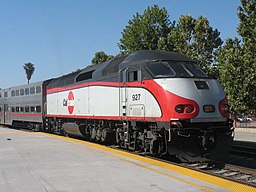Does building a new transit line trigger ridership? Does it even make sense to talk about the ridership of a piece of transit infrastructure?
If you say yes, you're expressing an infrastructurist world-view that is common in transit investment discussions. The right answer to the above questions, of course, is "No, but:
- Infrastructure permits the operation of some kind of useful transit service, which consists of vehicles running with a certain speed, frequency, reliabilty, civility and a few other variables.
- That service triggers ridership."
To the infrastructurist, this little term — "service" — is a mere pebble in a great torrent of causation that flows from infrastructure to ridership. By contrast, service planners, and most transit riders that I've ever met, insist that service is the whole point of the infrastructure.
If you read the literature of infrastructure analysis, you encounter the infrastructurist world view all the time, mostly in ways that's unconscious on the authors' part but still a source of confusion. This afternoon I was browsing TCRP 167, "Making Effective Fixed-Guideway Transit Investments: Indicators of Success", which includes some really useful explorations of land use factors affecting the success of transit lines. But when they talked about infrastructure features as causes of ridership, the report routinely delivered weirdness like this:
The percentage of the project’s alignment that is at grade proved to be a negative indicator of project-level ridership. At-grade projects may be more prevalent in places that are lower in density, while transit is more likely to be grade-separated in places with higher density or land value. Thus, this indicator may be reflective of density. It may also be true that at-grade systems are slower than grade-separated systems. At-grade status may reflect a bundle of operational characteristics such as speed, frequency, and reliability, although the analysis did not find that these factors individually had a statistically significant effect on ridership. [TCRP 167, 1-17]
This careful talk about how a correlation "may" reflect density or "operational features" sounds vague and speculative when it's actually very easy to establish. There is no shortage of evidence that:
- High density reliably triggers ridership.
- Areas of high density are less likely to have available surface rights of way.
- Therefore, highest ridership segments tend to be grade-separated.
So this is a case where "A correlates with B" does not mean "A causes B" or "B causes A". It means "A and B are both results of common cause C". It's important to know that, because it means you won't get B simply by doing A, which is the way that claims of correlation are usually misunderstood by the media and general public.
Later in the paragraph, the authors again describe the obvious as a mystery:
At grade status may reflect a bundle of operational characteristics such as speed, frequency, and reliability …
Yes, it certainly may, but rather than lumping all the at-grade rail projects together, they could have observed whether each one actually does.
… although the analysis did not find that these factors [speed, frequency, and reliability] individually had a statistically significant effect on ridership
While this dataset of new infrastructure projects is too small and noisy to capture the relationship of speed, frequency, and reliability to ridership, the vastly larger dataset of the experience of transit service knows these factors to be overwhelming. What's more, we can describe the mechanism of the relationship, instead of just observing correlations: Speed, frequency, and reliability are the main measures of whether you reach your destination on time. Given this, the burden of proof should certainly be on those who suggest that ridership is possibly unrelated to whether a service is useful for that purpose.
Note the word choice: To the infrastructurist, speed, frequency and reliability are dismissed as operational, whereas I would call them fundamental. To the transit customer who wants to get where she's going, these "operational" variables are the ones that determine whether, or when, she'll get there. It doesn't matter whether the line is at-grade or underground; it matters whether the service achieves a certain speed and reliability, and those design features are one small element in what determines that.
I deliberately chose a TCRP example because the authors of specific passages are not identified, and I have no interest in picking on any particular author. Rather, my point is that infrastructurism so pervasive; I hear it all the time in discussions of transit projects.
I wonder, also, if infrastructurism is a motorist's error: In the world of roads, the infrastructure really is the cause of most of the outcomes; if you come from that world it's easy to miss how profoundly different transit is in this respect, and how different the mode of analysis must be to address transit fairly.
Whenever you hear someone talk about the ridership of a piece of infrastructure, remember: Transit infrastructure can't get people to their destinations. Only transit service can. So study the service, not just the infrastructure!
